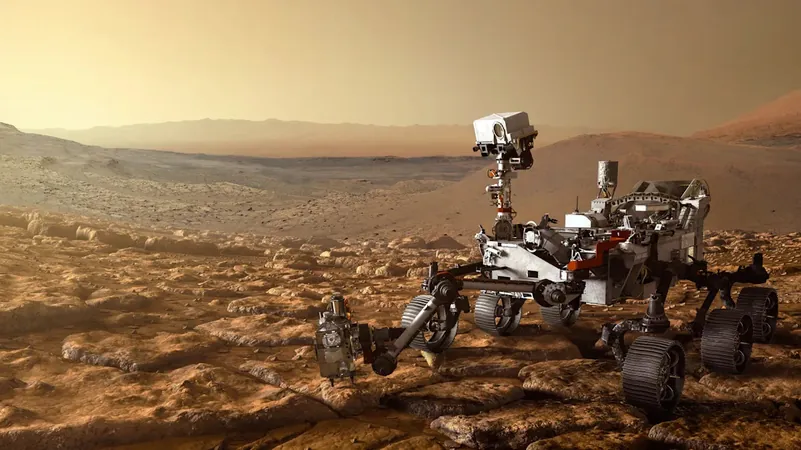
NASA's Bold New Plans to Bring Mars Samples Home: Everything We Know!
2025-08-28
Author: Daniel
NASA's Quest for Martian Treasures
Bringing samples from the enigmatic Red Planet back to Earth is one of NASA's most ambitious projects to date. This pursuit can be traced back to the 1970s, when the agency first began its robotic exploration program on Mars. The success of missions like Spirit, Opportunity, and Curiosity laid the groundwork for future explorations. In 2021, the Perseverance rover made history by collecting and caching environmental samples from Jezero Crater, a site believed to hold clues to ancient life on Mars. These treasures are now sealed in titanium tubes, patiently awaiting their journey home.
The Original Plan and Its Hurdles
NASA's initial Mars Sample Return (MSR) strategy was an elaborate multi-mission campaign featuring a Sample Retrieval Lander equipped with a sophisticated robotic arm and a small rocket to launch the samples into Martian orbit. An ESA orbiter would then intercept them for their return to Earth by 2033. However, unforeseen challenges have forced NASA to rethink this complex plan, particularly rising costs that could hit nearly $11 billion, along with various technical obstacles and potential delays.
The Reality Check: Exploring New Alternatives
In 2024, NASA admitted that the MSR project was no longer feasible in its original form. The agency is now on the hunt for faster and more economical solutions, considering partnerships with commercial heavyweights like SpaceX and Lockheed Martin.
Overcoming the Launch Dilemma
One of the toughest challenges in the Mars Sample Return mission has been figuring out how to lift the samples off the Martian surface. The heart of the original plan was the Mars Ascent Vehicle (MAV), designed to propel sample tubes into orbit. Launching a rocket from Earth is already a monumental feat, and doing so on another planet adds layers of complexity. The MAV must not only land successfully on Mars but also withstand its harsh conditions and perform a perfect vertical launch.
Navigating Martian Atmosphere: A Unique Challenge
NASA scientists face another hurdle with the Martian atmosphere. Although it's less dense than Earth's, it has unique properties. Any spacecraft that enters too fast can disintegrate upon entry, necessitating advanced thermal shielding; yet the atmosphere is too thin for parachutes alone to ensure a safe landing.
Two Promising Paths Forward
As of 2025, NASA is weighing two alternative strategies for its sample-return mission.
First is a streamlined version of the original MSR plan, utilizing the proven Sky Crane landing system that delivered the Curiosity and Perseverance rovers to Mars. This revised plan employs a lighter MAV powered by a Radioisotope Power System—guaranteeing consistent energy in Mars’ harsh conditions. The plan relies on Perseverance itself to transport the samples to the MAV, reducing overall mission complexity.
The second approach is to collaborate with industry giants such as SpaceX and Blue Origin. NASA has received eleven proposals suggesting innovative methods for the sample return, with potential costs ranging from $5.5 to $7.5 billion. By 2026, the agency aims to finalize a plan, with aspirations to have the samples back on Earth by 2040.
Stay Tuned!
As NASA forges ahead with its bold new strategies, the thrill of accessing Martian samples inches closer to reality. This journey into the unknown may one day reveal secrets of life beyond Earth!



 Brasil (PT)
Brasil (PT)
 Canada (EN)
Canada (EN)
 Chile (ES)
Chile (ES)
 Česko (CS)
Česko (CS)
 대한민국 (KO)
대한민국 (KO)
 España (ES)
España (ES)
 France (FR)
France (FR)
 Hong Kong (EN)
Hong Kong (EN)
 Italia (IT)
Italia (IT)
 日本 (JA)
日本 (JA)
 Magyarország (HU)
Magyarország (HU)
 Norge (NO)
Norge (NO)
 Polska (PL)
Polska (PL)
 Schweiz (DE)
Schweiz (DE)
 Singapore (EN)
Singapore (EN)
 Sverige (SV)
Sverige (SV)
 Suomi (FI)
Suomi (FI)
 Türkiye (TR)
Türkiye (TR)
 الإمارات العربية المتحدة (AR)
الإمارات العربية المتحدة (AR)